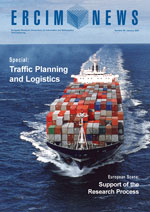by John Polak
The impact of road traffic on local air quality is of major concern in public policy, and in recent years has stimulated a substantial body of research. This is aimed at improving underlying vehicle and traffic management technology and informing public policy action. Recent work has begun to exploit the capability of a variety of vehicle-based, person-based and infrastructure-based sensor systems to collect real-time data on important aspects of driver and traffic behaviour, vehicle emissions, pollutant dispersion and concentration, and human exposure.
The variety, pervasiveness and scale of these sensor data will increase significantly in the future as sensors become cheaper, smaller and lower in power consumption. This has the potential to improve our understanding of urban air pollution and hence urban air quality. However, handling the vast quantities of real-time data that will be generated by these sensors will be a formidable task. In the case of static sensor grids, significant progress has already been made in the application of e-Science technology to the challenges of real-time data mining and distributed processing.
However, Grids comprising vehicle-based and person-based environmental sensors will be inherently mobile and dynamic in nature, and as such raise significant new challenges. These will require the integration of e-Science with communication and positioning technology, and the linking of all three with domain-specific transport and environmental modelling tools and methods.
Such an integration is the objective of the recently established MESSAGE project (Mobile Environmental Sensor Systems Across a Grid Environment). The project is funded by the UK Engineering and Physical Sciences Research Council and the UK Department for Transport, and involves collaboration between a multidisciplinary team of researchers based at Imperial College London and the Universities of Cambridge, Leeds, Newcastle and Southampton.
There are two main aims of the project. The first is to harness the potential of diverse, low-cost and ubiquitous environmental sensors. These will provide data to address key scientific challenges in the field of transport and environmental monitoring, and modelling and analysis. The second is to develop a flexible and reusable e-Science infrastructure. This will support a wide range of scientific, policy-related and commercial uses and applications for the resultant data, and demonstrate the operation and utility of this infrastructure in a number of case study applications.
The project will develop the capability to equip vehicles and pedestrians with a range of environmental sensors, to track the position of these sensors in the urban environment (using a combination of GPS and wireless network positioning), to retrieve data from them in real time, to integrate these data with those from more conventional (static) environmental and traffic sensors and to estimate pollutant concentrations and individual exposure. The project will build on and extend a number of outputs from the UK e-Science programme, including the DiscoveryNet project (http://www.discovery-on-the.net) and the OGSA-DAI and OGSA-DQP projects (http://www.ogsadai.org.uk), as well as taking advantage of extensive experience across the consortium in measuring and modelling the environmental impacts of traffic.
The case-study applications will be carried out in London, Cambridge, Gateshead and Leicester. They will build on the Universities' existing collaborative arrangements with the relevant local authorities in each site, drawing on substantial existing data resources, sensor networks and ongoing EPSRC and industrially funded research activities. These applications will address important problems that to date have been difficult or impossible to solve due to a lack of relevant data. These problems are of three main types: (i) measuring human exposure to pollutants, (ii) the validation of various detailed models of traffic behaviour and pollutant emission and dispersion, and (iii) the development of transport network management and control strategies that take account not just of traffic but also air quality impacts. The various case studies will look at different aspects of these questions and use a variety of different types of sensor system to do so. In particular, existing sensor networks in each city will be enhanced by the selective deployment of a number of new sensor types (both roadside and on-vehicle/person) to increase the diversity of sensor inputs.
Links:
http://www.message-project.org
http://www.imperial.ac.uk/cts
Please contact:
John Polak
Imperial College London, UK
E-mail: j.polak![]() imperial.ac.uk
imperial.ac.uk










